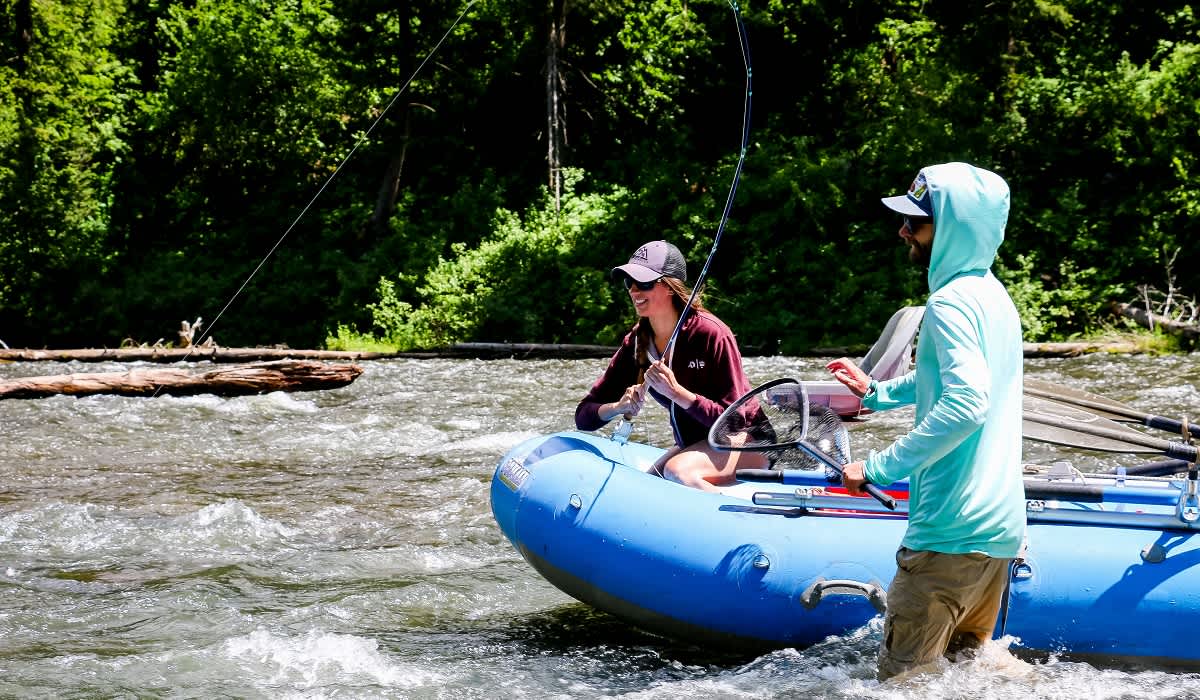This Fly Combination Will Help You Catch More Fish This Summer
OutdoorHub Reporters 07.24.20

The dry dropper rig is a time tested set up that is guaranteed to catch you more fish late into the summer.
Late summer is prime time fly fishing for trout. Whether you’re after native cutthroat in high alpine streams, or chunky stocked rainbows in the Appalachia, one thing is for sure; you want to be fishing a dry dropper rig.
The What
The dry dropper rig is time tested and proven to catch trout throughout the country, especially as temperatures heat up during the summer months. It starts with a large dry fly that is trailed by a nymph. The dry fly can be eaten on its own, but it also serves as a strike indicator for the nymph floating below the surface.

The When
Most of the time you’ll want to tie on a dry dropper when fishing smaller streams with clear water, gentle flows, and spooky fish. These conditions produce trout that are “smart” with their dinner selection. This is because the clear, gentle flowing water allows the fish to get a much better look at your fly as it drifts by and thus, are more apt to skip presentations that feel out of the ordinary.
The How

Start with your favorite rod and reel setup that matches the size of the water and the fish you’re targeting. I tend to reach for my 9’ 5-weight coupled with a 5x tapered leader. This set up is incredibly versatile; it has the length to reach out and control drifts, the power to reach far banks, and the line weight to handle big trout. By adding a couple feet of 5x tippet to the end of the leader you’ll increase the lifetime of your leader tenfold.
Next, attach your dry fly of choice. You want to choose something large enough to carry the weight of the nymph without sinking. I opt for larger attractors and stimulator patterns. Make sure to use some flotant on your dries for optimal buoyancy.
Now here comes the “dropper” portion of the setup — the nymph. Tie the nymph onto the bend of the dry fly hook with some smaller diameter tippet and an improved clinch knot. I prefer to use fluorocarbon because it is nearly invisible when it is submerged under water (important because remember, we’re fishing in clear gentle flowing water). The length of your tippet will vary depending on water depth. You want the nymph to bounce and hover right above the bottom of the creek bed.
I prefer using a tungsten beaded nymph over split shot to sink my nymph. Split increases the likelihood of tangles and break offs, while a tungsten beaded nymph will help it sink without any mess or any potential damage to the tippet.
Sticking to short casts and roll casts are also something I tend to find myself doing with this particular setup.
The Why
For some reason, dry dropper rigs don’t seem to spook fish as much as a classic nymph / indicator set ups. Maybe it is because the dry fly does not produce as much disturbance on the water as it lands, or maybe it is because the rig has an overall more natural presentation. Either way, I like the fact that my dry fly is playing double duty. It serves as a strike indicator for my nymph and increases my chances of catching fish by serving as a second fly for the fish to gobble up.

Another plus to this setup — you don’t have to change rigs every 100 yards. No matter what type of water you encounter, your rod is ready to go with both a nymph and a dry fly. Yes, it is true that this set-up is best suited for clear gentle flowing water, but it’s incredibly versatile and will work flawlessly in a number of other water conditions too.
If you’re digging for a negative here, it’s that tangled messes happen. But not as often as you’d think. Typically things become tangled on a dry fly strike and when you get a fish in the net, but hey if you have a strike or landed a fish you’re already ahead of the game.
In Conclusion
The dry dropper setup is one to try next time you’re on the water. It’s a versatile rig effective for both seasoned and newbie anglers alike. You just might find yourself tying up this tandem more often than you’d think.

